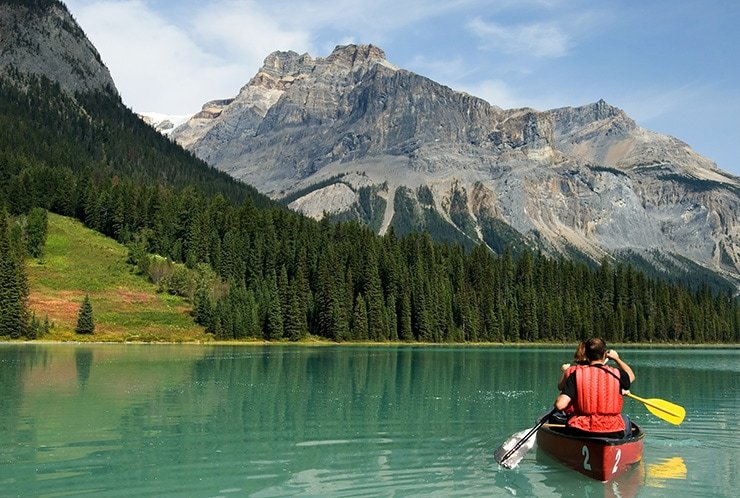Can’t differentiate between a canoe and a kayak? You’re not alone!
Canoes and kayaks have been around for centuries. But many people still can’t tell the difference. Others don’t even know that they’re different and use the two terms interchangeably.
Not only are these paddlecraft different, but there has always been a debate about which one is better. It can leave you confused if you’re trying to get into paddling but have no idea how to choose between the two.
So here I’l dive, with great detail, into the canoe vs kayak debate – and answer any common questions anyone comparing a canoe vs kayak might have.
What’s the difference between a kayak and a canoe? Which one would be best for your needs? Keep reading to find out everything you need to know.
Key Takeaways
- Canoes and kayaks are different types of small boats propelled by paddles, each with its own advantages and disadvantages.
- Canoes have an open deck, a single-bladed paddle, a higher seating position, and more storage space and weight capacity than kayaks.
- Kayaks have either a sit-on-top or a sit-inside cockpit, a double-bladed paddle, and a lower seating position, and are more streamlined, faster, and maneuverable than canoes.
- Both canoes and kayaks come in different sizes, shapes, and materials, depending on their intended use. There are recreational, whitewater, racing, fishing, and other types of canoes and kayaks.
- When choosing between the two consider what you’ll be using the vessel for, whether or not you’ll be paddling with family, your budget, and where you’ll be paddling.
What Is a Canoe?
First of all, let’s lay down some definitions. In order to know the difference between a canoe vs kayak, you’ll first need to know what each of these paddlecraft are.
A canoe is a small boat with an open deck, pointed on both ends. It is propelled using a single-bladed paddle.
Humans have used canoes for thousands of years and the shape has changed a lot–from a simple dugout canoe to the modern ones we see today.
Canoes come in different sizes and shapes, depending on the intended use. The different canoe types include recreational canoes, whitewater canoes, racing canoes, and more.
The construction materials have also evolved. There are fiberglass, plastic, and even kevlar canoes.

What Is a Kayak?
A kayak is a small and slim boat, propelled using a double-bladed paddle.
Kayaks can either be sit-on-tops or sit-ins (these are the two main differentiators, but you’ll also find other types like tandem kayaks).
Sit-on-top kayaks have an open deck and a molded seat for you to sit in. Sit-in kayaks have an enclosed cockpit. Your lower body goes into the cockpit and you stretch your legs under the deck.
The origin of the kayak can be traced back to the Inuit, Yupik, and the Aleut–indigenous people of the subarctic regions.
The ancient kayak was made using animal skin stretched over a whalebone or wood frame. Today, kayaks are built with plastic, fiberglass, and wood.
There are also inflatable kayaks made of hypalon or PVC and foldable kayaks which feature collapsible frames of wood or aluminum and a waterproof fabric.
Like canoes, different kayaks are designed for different uses. There are recreational kayaks, sea or racing kayaks, whitewater kayaks, surfing kayaks, and fishing kayaks.
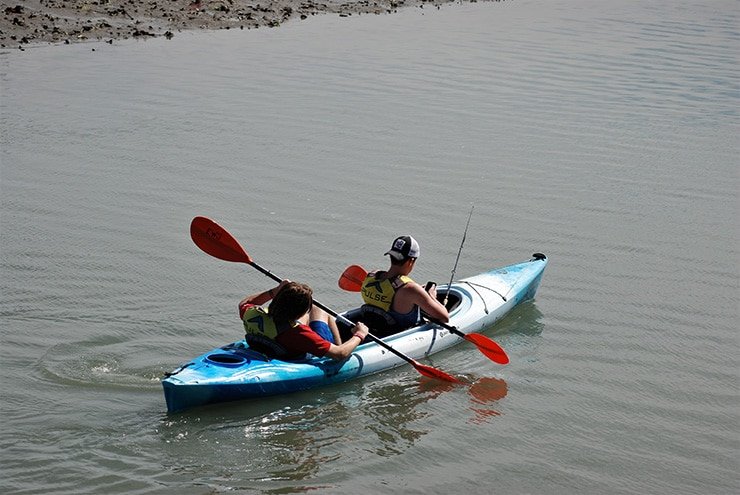
Key Differences Between a Canoe and Kayak
As you can see, there are some major similarities between kayaks and canoes. They are both small boats, propelled using a paddle. They are made using pretty much the same materials and they are designed for different purposes.
But they also have some major differences. Take a look.
Hull Design of a Canoe vs Kayak
The hull is the bottom part of a canoe or kayak, the one that makes contact with the water.
A canoe hull is long, broad, and heavy. A kayak, on the other hand, has a smaller, narrower, and more streamlined hull.
When you put a kayak and a canoe side by side, you’ll notice that a canoe is significantly bigger. The sides are also higher.
While a kayak hull and a canoe hull are different, you should also know that not all canoe hulls and kayak hulls look the same. I’ve mentioned above that different kayaks and canoes are designed for different uses.
So kayak and canoe hulls come in different shapes to suit the specific purpose it is designed for.
Canoe Paddle Vs Kayak Paddle
Another significant difference between a kayak and a canoe is the type of paddle you use while propelling the two.
A canoe paddle is single-bladed, with a blade on just one side. You have to alternate paddling sides by moving the blade from one side of the vessel to the other.
The canoe paddle is not an oar, it’s a paddle–there’s a difference.
A kayak paddle is double-bladed; it has a blade on either side. You don’t have to move the blade across the boat to the other side to alternate paddling sides.
ALSO READ: Can You Use a Kayak Paddle With a Canoe?
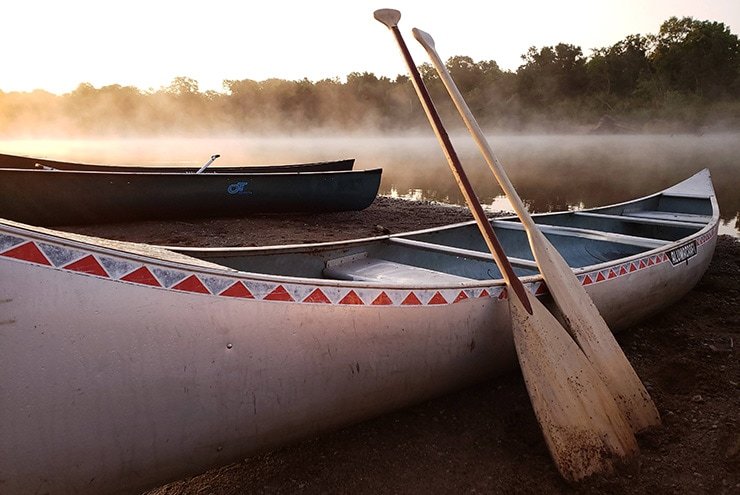
Cockpit Design
A canoe has an open cockpit and looks a lot like a traditional rowing boat. Canoes have raised seating that’s slightly below the gunwale level.
A kayak can have either one of two cockpit types. Sit-inside kayaks have an enclosed cockpit. Unlike a canoe, the entire deck is not open and the seat is much lower.
With sit-on-top kayaks, the deck is open but the sides are not as high as a canoe’s. The seating is also not raised, instead, it’s molded on the deck.
Storage Space and Weight Capacity
Canoes are big, with higher sides and an open deck. This translates to a lot of storage space. They also have a high weight capacity, some as high as 1000 pounds. The average weight limit of a canoe is about 800 pounds. You can fit so much gear into a canoe and still have space for an extra passenger.
Kayaks, being much smaller and without an open deck, don’t have as much onboard storage.
But it depends on the type of kayak you get. Sit-in sea kayaks have significant storage space. Many of them have dry hatches and bungee storage areas. You can also store some gear inside the cockpit. The storage is still smaller compared to a canoe’s though.
Sit-on-top recreational kayaks have the least storage space. You typically get a bungee storage area at the front or two, at the front and the back, and that’s it.
The weight capacity of a kayak is also much lower than that of a canoe. The average weight limit is around 350 pounds. Fishing kayaks usually have a higher capacity, but they still don’t come close to a canoe.
Canoe Vs Kayak: The Pros and Cons
Kayaks and canoes each have their advantages and disadvantages:
| Craft | Canoe | Kayak |
| Pros | Easy to enter and exit Higher seating position Space for more passengers Better stabilitySpacious | Faster and more maneuverable Kayaks are versatile Smaller and lighter Double-paddle blade You’ll stay dry Comfortable seat |
| Cons | More exposure to the elements No back support Single-blade paddle Not very maneuverable Bigger and bulkier | Not easy to enter and exit Hard to stay dry Limited storage space Less space and lower weight limit |
Let’s take a look at each of these pros and cons in a little more detail.
Pros of a Canoe
Easy to enter and exit: A canoe has a large open cockpit that you can easily jump in and out of. Unlike a kayak, you don’t have to wiggle in and out of a small cockpit. This is good news for beginners because they’ll have an easy time learning how to launch the canoe.
Higher seating position: the seat of a canoe is usually just below the gunwell level. Canoes have high sides so you’ll be sitting higher above the water than you would be in a kayak. This means that you get a better view of your surroundings. The high seating also makes it easier for you to stay dry.
Space for more passengers: Canoes are bigger with a higher weight capacity so you can bring more people with you. A canoe is big enough for you to paddle with your kids, dogs, or partner–and it won’t feel crowded.
Better stability: Whether or not a canoe is stable depends on several factors, including the hull type. But in general, canoes are bigger and wider than kayaks. Newbies will find a canoe less tippy than a kayak.
Spacious: Due to the large size and completely open deck of a canoe, it’s much more spacious than a kayak. This makes it more suited for long-distance paddles. It’s more comfortable and you can change sitting positions to avoid fatigue and even stand to stretch your legs and give your back a break. More space also means you can bring all the camping gear you’ll need for multi-day excursions.
Cons of a Canoe
Exposure to the elements: The open deck of a canoe makes it spacious but it also means that you’re more exposed to the elements.
No back support: Most canoes don’t have the most comfortable seat and they have zero back support. If you spend a lot of time on a canoe your back will soon start to feel the effect.
Single-blade paddle: Canoe paddles have a single blade. To paddle on the other side you have to move the blade across the canoe, making paddling less efficient.
Not very maneuverable: The size of a canoe makes it harder to control, especially when solo paddling. Canoes are much less maneuverable and you may have to put in more effort to paddle efficiently.
Bigger and bulkier: Canoes are larger, heavier, and bulkier. They can be a pain to transport, especially when you’re alone. They also require more storage space which many people may not have.
Pros of a Kayak
Faster and more maneuverable: The average kayak is smaller, sleeker, and easier to paddle than a typical canoe. You can paddle a kayak faster with less effort and it’s also easier to make quick sharp turns compared to paddling a canoe.
Kayaks are versatile: There are more kayaking disciplines than there are canoeing disciplines. You can do so much more with a kayak, including extreme whitewater paddling, than you can do with a canoe.
Smaller and lighter: Most kayaks are small and not as heavy as canoes. They are easier to transport, even when you don’t have a paddling buddy. They require less storage space and are more convenient for most people. You can even get an inflatable kayak which will fit under the bed when deflated.
Double-paddle blade: Kayak paddles have a blade on either side so you don’t have to move the paddle across the boat to paddle on the other side. This allows you to paddle much more efficiently without losing momentum.
You’ll stay dry: With a sit-inside kayak, your lower body is completely protected from the elements and you can stay completely dry with a spray skirt.
Comfortable seat: Most kayaks, especially sit-inside kayaks come with padded seats and some kind of back support. They are more comfortable and kinder to your back. Besides, there are many comfortable after-market kayak seats so you can always upgrade to a better one.
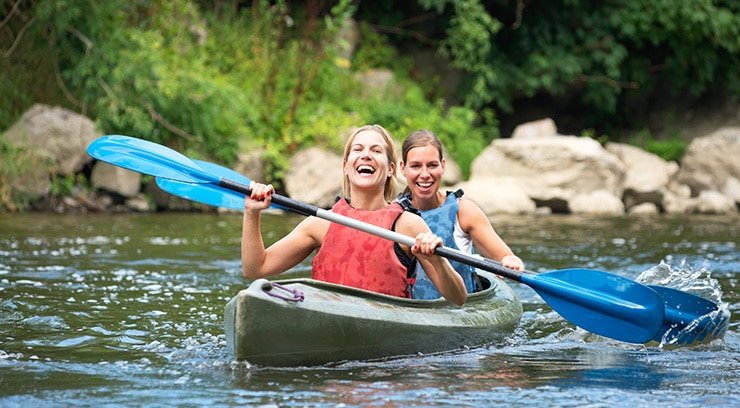
Cons of a Kayak
Not easy to enter and exit: Entering and exiting a sit-in kayak, especially a long narrow sea kayak, can be hard. It may take beginners some time to get the hang of it. It’s also not ideal if you love to jump in for a quick swim mid-paddle.
Hard to stay dry: Unlike a canoe, you sit lower in a kayak. If you have a regular sit-on-top recreational kayak, you won’t be able to stay dry because there’s no closed deck.
Limited storage space: Kayaks have limited storage space and even touring kayaks don’t have as much onboard storage as canoes. If you’re going on a long trip, you can’t bring everything you want–only what you truly need.
Less space and lower weight limit: With most kayaks, especially expedition kayaks, you can’t bring passengers if it’s a single-person kayak. They’ll have nowhere to sit. You can bring a kid or dog on a sit-on-top kayak but it still won’t be as spacious as a canoe. Plus, the weight limit of a kayak is considerably lower than that of a canoe.
Canoe Vs Kayak: Which One Should I Choose?
Now that you know the difference between a kayak and a canoe, as well as their pros and cons, the next step is deciding which one would be best for you.
Here are some key factors to consider.
What Will You Use Your Kayak or Canoe For?
One of the most important things to have in mind is what you want to use your kayak or canoe for.
If you want a touring vessel with great speed then you’re better off with a kayak. Kayaks are smaller and much more streamlined, so you can cover longer distances in a shorter amount of time.
You should also consider a kayak if maneuverability is particularly important to you. The size, shape, and design of a kayak make it easier to control, even for beginners.
This is not to say that canoes aren’t fast or maneuverable. There are canoes designed for speed and others for maneuverability. But if you compare them to kayaks, kayaks are the clear winners.
Another question you need to ask yourself is how often you’ll be exiting and re-entering your paddlecraft.
You may need to exit and re-enter your boat often for a quick swim, to explore, or portage your vessel. If this is what your typical paddling adventure looks like, a canoe may be more suited. Getting in and out of a canoe is much less trouble compared to a sit-inside kayak.

Will You Be Paddling Alone, or with Family?
Canoes tend to have a much higher weight capacity, usually 800+ pounds. A regular canoe will easily hold you and your kids or buddy and you don’t have to worry about exceeding the weight limit. There’s also enough space for multiple people in a canoe.
A kayak typically holds one person and maybe a dog or child. Sit-inside kayaks will most likely only accommodate one person. So without a tandem kayak, you can’t bring your family with you, unless they get their own kayak.
If you like going on solo paddling adventures, you’ll love a kayak. It will be just enough for you and your luggage.
However, if paddling is more fun for you with friends, consider getting a canoe. Anyone can join you and they don’t have to buy their own canoe.
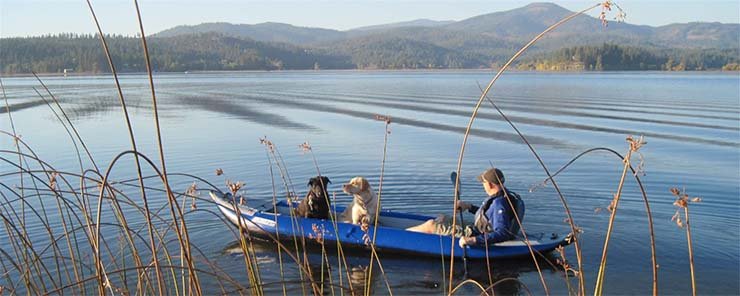
How Much Onboard Storage Do You Need?
This is another key factor that you should take into account when choosing between a kayak and a canoe.
For paddlers who only go on short recreational trips, this may not be important. You don’t need to bring a lot of stuff for one or two hours of paddling.
But if you go on long touring or camping trips, then you have to consider onboard storage.
Are you a minimalist who only brings what they’ll strictly need or do you like the idea of packing whatever you want?
Your average canoe is big enough to fit all your basic accessories plus extra stuff. Canoe enthusiasts can carry as much gear as they want because they have the space and their vessels can handle it.
A kayak, on the other hand, will limit you in this area. The storage space on a regular kayak is not that much and the weight capacity is usually not that high. You won’t have the freedom to bring all your stuff.
What’s Your Budget?
Both kayaks and canoes can be super expensive, costing thousands. But on average, a kayak is cheaper than a canoe.
You can get a good sit-on-top entry-level kayak for less than $500 and inflatable kayaks are even cheaper. For a canoe, you’ll have to dig slightly deeper into your pocket.
However, it all depends on the type of kayak or canoe you want. Both recreational canoes and recreational kayaks are affordable, with canoes costing just a little bit more.
But when you start looking at specified models –those designed for specific paddling sports–the prices start getting crazier. Specialized fishing kayaks, for instance, can cost as much as $2000+.
So it all comes down to the type of kayak or canoe you want.
Do You Have Enough Storage Space?
Kayaks are smaller and they can fit in smaller storage spaces; so they’re easy to store. Canoes are bigger, which means you’ll need to have a large storage area.
If you have a lot of free space in your home then a canoe won’t be a problem. But if space is tight then you’ll be better off with a kayak. Besides, you can get an inflatable kayak which is much easier to store than a solid one.
Where Will You Be Paddling?
Both the canoe and the kayak can be used in most paddling environments, but they each have their strengths.
The canoe is more stable and spacious. It would be great for a paddler who intends to paddle slow-moving rivers and calm lakes with their loved ones. It’s perfect for paddling leisurely to your camping destination or to just enjoy a sunny day at the water.
For whitewater rapids and other paddling environments that require agility and speed, you may want to go with the kayak. It’s ideal for paddlers who like thrilling adventures.
Which Is More Stable: a Canoe or a Kayak?
A canoe is generally more stable than a kayak.
When it comes to the stability of kayaks and canoes, there’s primary and secondary stability.
Primary stability is the stability of a boat when it’s resting upright on calm water. Secondary stability is the stability of a vessel when it’s leaning to one side.
In general, canoes have better primary stability, which is the one that beginners will be mostly concerned about. So you’ll find it more stable when paddling calm lakes and sheltered coastal areas.
Is Canoeing or Kayaking Easier?
Kayaking is easier than canoeing and beginners will have a harder time learning canoeing compared to kayaking.
The basic paddling techniques for kayaking are easier to master. Besides, kayaks are smaller and you won’t have trouble learning to control one.
However, there are some advanced kayaking techniques that may take time to learn.
Canoeing or Kayaking: Which Is Better?
This is a matter of personal preference.
If you want a bigger vessel that’s stable and can accommodate a lot of gear and your family, canoeing would be better for you.
If you prefer a sleeker boat that’s more maneuverable and easier to store and transport then kayaking would be better for you.
Do Canoes Flip Over Easily?
No, canoes don’t flip over easily, especially on flat water.
As long as you arrange your gear properly and all your passengers are where they’re supposed to be, you have nothing to worry about.
Do Kayaks Flip Over Easily?
No. Kayaks don’t flip over easily.
If you’re paddling a stable recreational kayak on a calm lake it won’t flip easily. Just ensure you choose the right kayak for your skill level and the conditions you’ll be paddling in.
Canoe Vs Kayak: Summary
Canoes and kayaks can be hard to distinguish, especially when people use the terms interchangeably. But the two are quite different in size, appearance, and how they are propelled.
The canoe is bigger and heavier. Its paddle has a single blade. Kayaks are smaller compared to canoes and they have double-bladed paddles.
The two water vessels each have their pros and cons. To decide between the two, you have to consider a number of factors such as onboard storage, where you’ll be paddling, who you’ll be paddling with, and the available storage space you have.
The canoe is more suited for the paddler who likes to bring a lot of gear and extra passengers. The kayak is more suited for the paddler who wants agility and speed.

